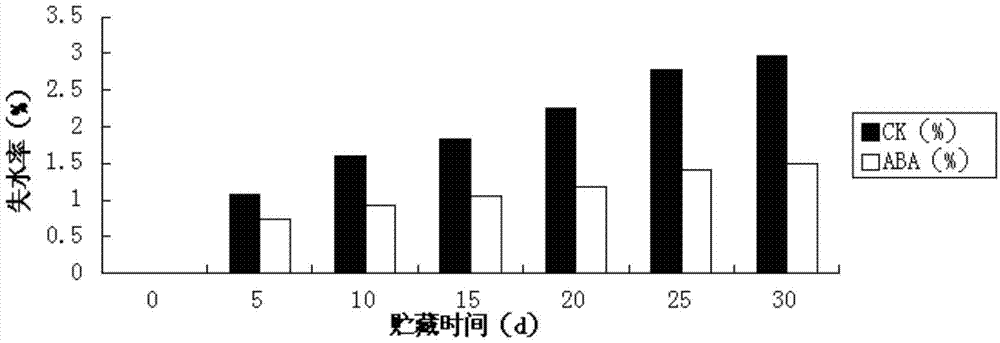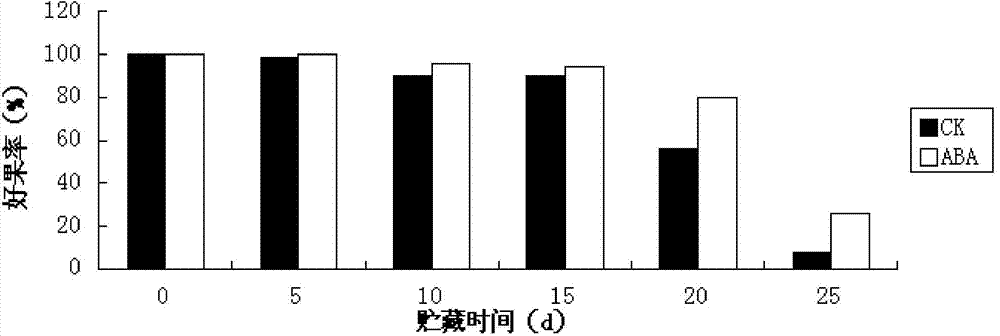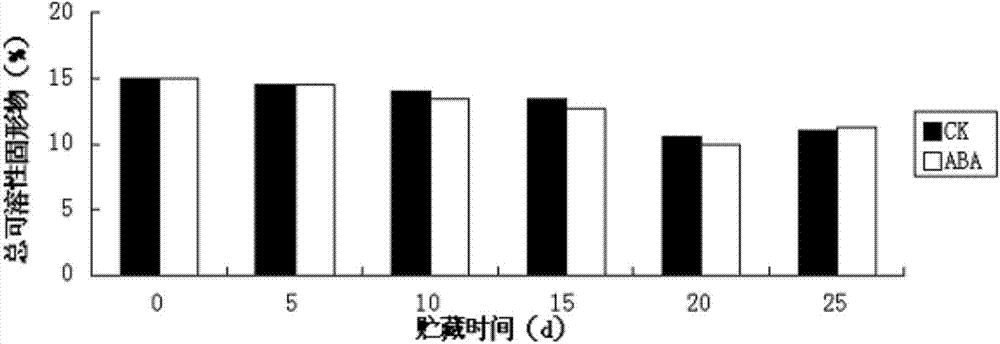Method for preserving sweet cherries by utilizing abscisic acid
A technology of abscisic acid and sweet cherries, which is applied in the fields of fruit and vegetable preservation, application, and food preservation. It can solve the problems of prolonging the preservation period of sweet cherries, and achieve the goal of enhancing resistance to external stress, high commodity value and edible value, and reducing rot rate. Effect
- Summary
- Abstract
- Description
- Claims
- Application Information
AI Technical Summary
Problems solved by technology
Method used
Image
Examples
Embodiment 1
[0022] The fresh-keeping method for treating sweet cherries with abscisic acid comprises the following steps:
[0023] Soak sweet cherry fruits with uniform size and no mechanical damage in abscisic acid solution for 20 minutes, take them out, and dry them in the air; put them in a PVC film bag, and place them for 6 hours at 4°C and a relative humidity of 78% with the mouth of the bag open. Pocket, stored at 4°C for 20 days, the good fruit rate is 80%. The preparation of the abscisic acid solution is: dissolve 50 mg of abscisic acid in 5 mL of ethanol solution with a volume concentration of 75%, and dilute to 1 L with distilled water. .
[0024] During storage, detect changes in water loss rate, good fruit rate, total soluble solid content, firmness, cell membrane permeability, CAT activity, POD activity and PAL activity of sweet cherry fruits. Figure 1-Figure 8 . CK in the figure is the control group, and ABA is the abscisic acid group.
Embodiment 2
[0026] The fresh-keeping method for treating sweet cherries with abscisic acid comprises the following steps:
[0027] Soak sweet cherry fruits with uniform size and no mechanical damage in abscisic acid solution for 25 minutes, take them out, and dry them in the air; put them into PVC film bags, and place them for 6 hours at 4°C and 78% relative humidity with the mouth of the bags open, and tie them up. Pocket, stored at 4°C for 20 days, the good fruit rate reached 78%. The preparation of the abscisic acid solution was: dissolve 750mg of abscisic acid in 7mL of ethanol aqueous solution with a volume concentration of 75%, and distilled water to 1L. .
[0028] After determination, the water loss rate, good fruit rate, total soluble solid content change, hardness change, cell membrane permeability change, CAT activity change, POD activity change and PAL activity change of sweet cherry fruit were detected during storage Similar to the detection result of Example 1.
Embodiment 3
[0030] The fresh-keeping method for treating sweet cherries with abscisic acid comprises the following steps:
[0031] Soak sweet cherry fruits with uniform size and no mechanical damage in abscisic acid solution for 15 minutes, take them out, and dry them in the air; put them into PVC film bags, and place them for 6 hours at 4°C and a relative humidity of 78% with the mouth of the bags open. Bag mouth, stored at 4°C for 25 days, the good fruit rate reached 80%. The preparation of the abscisic acid solution was: dissolve 100mg of abscisic acid in 10mL of ethanol aqueous solution with a volume concentration of 75%, and distilled water to 1L. .
[0032] After determination, the water loss rate, good fruit rate, total soluble solid content change, hardness change, cell membrane permeability change, CAT activity change, POD activity change and PAL activity change of sweet cherry fruit were detected during storage Similar to the detection result of Example 1.
PUM
 Login to View More
Login to View More Abstract
Description
Claims
Application Information
 Login to View More
Login to View More - R&D
- Intellectual Property
- Life Sciences
- Materials
- Tech Scout
- Unparalleled Data Quality
- Higher Quality Content
- 60% Fewer Hallucinations
Browse by: Latest US Patents, China's latest patents, Technical Efficacy Thesaurus, Application Domain, Technology Topic, Popular Technical Reports.
© 2025 PatSnap. All rights reserved.Legal|Privacy policy|Modern Slavery Act Transparency Statement|Sitemap|About US| Contact US: help@patsnap.com



